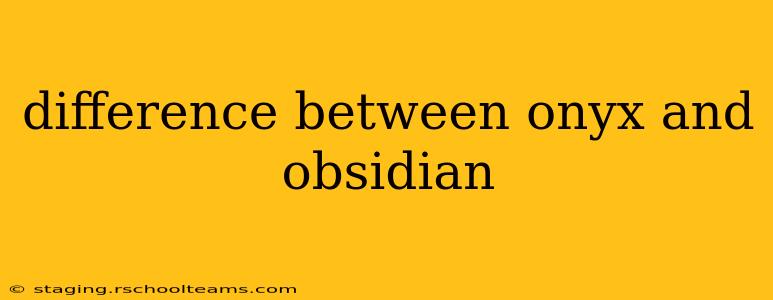Onyx and obsidian are both captivating dark-colored stones often used in jewelry and decorative objects, but they possess distinct differences in their formation, properties, and appearance. Understanding these differences allows for a more informed appreciation of their unique beauty and value.
What is Onyx?
Onyx is a variety of chalcedony, a cryptocrystalline form of quartz. This means it's composed of microscopic quartz crystals, too small to be seen with the naked eye. Its defining characteristic is its banded structure, showcasing parallel layers of contrasting colors, most commonly black and white, but also brown, red, or even green. This banding is what creates the dramatic visuals often associated with onyx. Its hardness is around 6.5 to 7 on the Mohs Hardness Scale, making it relatively durable for jewelry.
How is Onyx Formed?
Onyx forms in cavities within rocks, where silica-rich solutions gradually deposit layers of mineral material. The banding is a result of variations in the mineral composition or deposition rates during this process. It's often found in sedimentary rocks like limestone.
What is Obsidian?
Obsidian, unlike onyx, is a volcanic glass. It's formed when molten lava cools rapidly, preventing the formation of mineral crystals. This rapid cooling results in a smooth, glassy texture. Obsidian is typically black, but variations can occur, depending on the presence of trace minerals. It can range from jet black to shades with reddish-brown, gray, or even iridescent hues. It has a hardness of about 5 to 5.5 on the Mohs Hardness Scale, making it slightly softer than onyx.
How is Obsidian Formed?
Obsidian is a product of volcanic activity. It forms when felsic lava (lava rich in silica) erupts and cools quickly, typically as a lava flow or in a volcanic dome. This rapid cooling prevents the growth of crystals, resulting in its amorphous, glassy structure.
Key Differences Between Onyx and Obsidian: A Summary Table
| Feature | Onyx | Obsidian |
|---|---|---|
| Formation | Sedimentary, from silica solutions | Volcanic, from rapidly cooled lava |
| Composition | Cryptocrystalline quartz (chalcedony) | Volcanic glass |
| Hardness | 6.5 - 7 on Mohs scale | 5 - 5.5 on Mohs scale |
| Color | Typically banded, black and white, but can be other colors | Typically black, but can have other hues |
| Texture | Smooth, but can show banding | Smooth, glassy |
| Transparency | Can be translucent to opaque | Usually opaque |
Is Onyx More Valuable Than Obsidian?
The value of both onyx and obsidian depends on various factors, including color, clarity, banding (in onyx), and the quality of the cut and polish. Generally speaking, high-quality onyx, particularly those with distinct and vibrant banding, can command higher prices than most obsidian. However, rare obsidian varieties, such as rainbow obsidian or snowflake obsidian, can also be highly valued by collectors.
What are the Uses of Onyx and Obsidian?
Both stones have been used for centuries in various applications:
- Jewelry: Both are popular in jewelry making, with onyx often used for cameos and intaglios, showcasing its banding.
- Ornamental Objects: Both are used in decorative objects, such as bowls, vases, and sculptures.
- Tools (Historically): Obsidian's sharp edges made it useful for tools in prehistoric times.
How Can I Tell the Difference Between Onyx and Obsidian?
The easiest way to distinguish between onyx and obsidian is to examine their texture and banding. Onyx typically shows distinct banding, whereas obsidian has a uniform, glassy texture. A hardness test (though not recommended for casual identification) could also help, as onyx is harder than obsidian.
This comprehensive comparison should help you confidently differentiate between these two fascinating gemstones. Remember to appreciate the unique beauty and geological history each stone holds.
